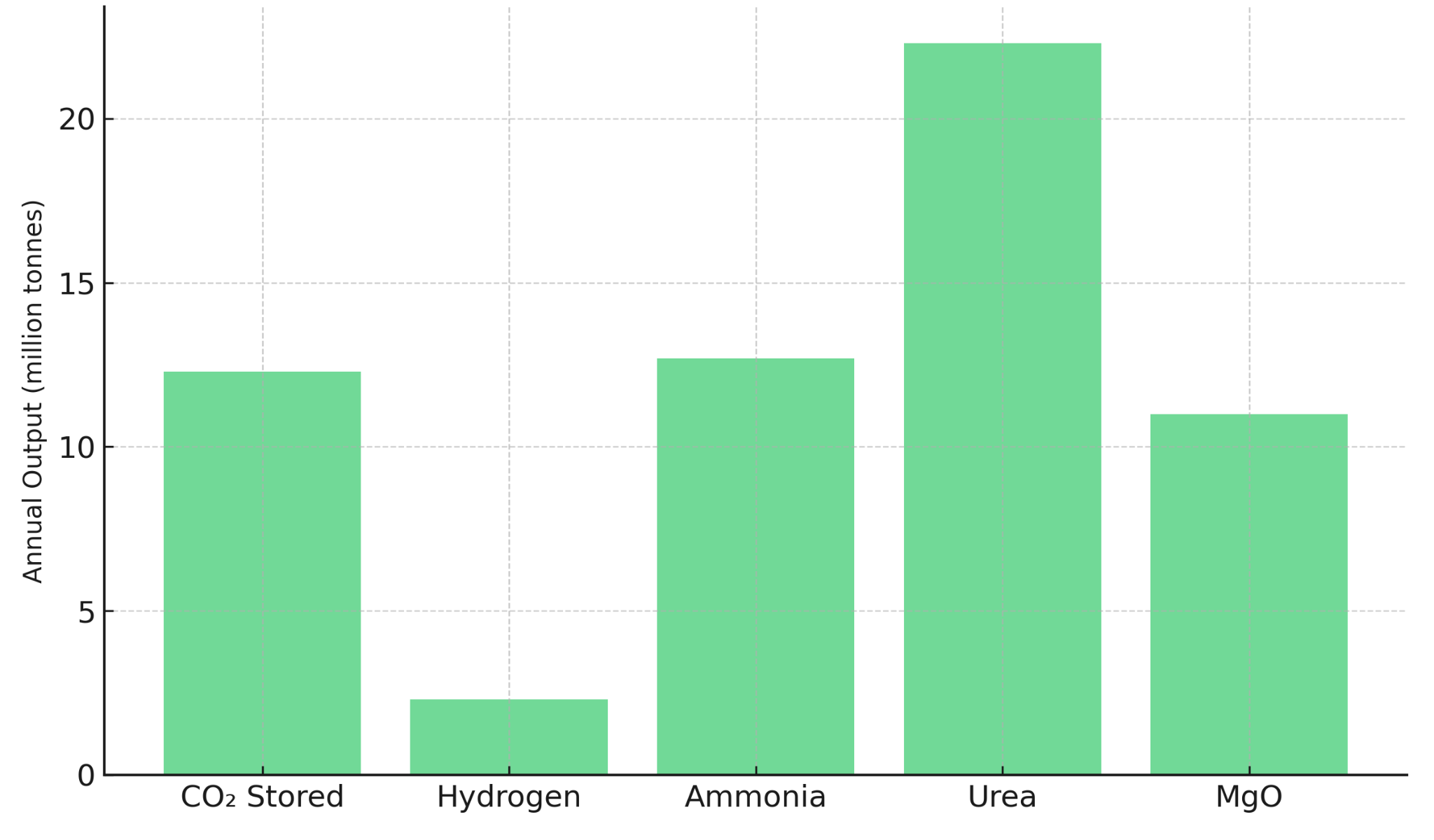Canada Nickel & NetCarb Advance a Zero-Carbon Industrial Cluster: Redefining Nickel's Strategic Role in North America's Decarbonisation Economy

Canada Nickel and University of Texas launch DOE-funded carbon sequestration pilot at Crawford, injecting CO2 into ultramafic rocks for permanent mineral storage.
- Canada Nickel and NetCarb are advancing a strategic partnership to develop a zero-carbon industrial cluster in Northeastern Ontario, leveraging tailings from the Crawford Nickel Project once operational.
- The initiative would introduce new revenue streams from hydrogen, ammonia, urea, and magnesium oxide, diversifying beyond core nickel production subject to successful technical and economic validation.
- NetCarb's technology has the potential to sequester up to 10 times more carbon dioxide than Canada Nickel's existing IPT Carbonation process, transforming tailings into permanent carbon storage assets.
- With permitting targeted for Fall 2025, construction decision by year-end 2025, and NetCarb lab-scale validation through 2026, the collaboration aligns with Canada's critical minerals and decarbonisation mandates.
- For investors, the development-stage project combines tier-one scale, projected low-cost production, ESG alignment, and multi-sector exposure, offering early access to a next-generation critical minerals district.
The New Frontier of Carbon-Linked Mining Economics
As decarbonisation capital inflows accelerate, carbon sequestration is evolving from a compliance metric into an investable industrial asset. Companies that can monetise their waste streams, particularly through verifiable carbon storage, stand to gain valuation premiums similar to those seen in renewable infrastructure.
Canada Nickel's partnership with NetCarb represents a first-of-its-kind step toward building a zero-carbon industrial cluster in Northeastern Ontario. Beyond nickel supply, it reframes mining tailings as feedstock for carbon storage and low-emission industrial inputs. This model could become a new benchmark for ESG-linked value creation in mining.
Canada Nickel & NetCarb: Building the Foundation for a Zero-Carbon District
Canada Nickel filed its Environmental Impact Statement in November 2024, completing the second stage of the federal permitting process. The company is targeting receipt of final permits by Fall 2025, with a construction decision anticipated by year-end 2025. Meanwhile, the NetCarb partnership advances on a parallel track, with funding proposals being submitted through the balance of 2025 to support joint process development.
NetCarb's proprietary technology accelerates mineral carbonation approximately 100 million times faster than natural rates, transforming serpentine tailings into stable carbonate minerals. Canada Nickel and NetCarb believe this technology has the potential to sequester up to ten times the amount of carbon dioxide that Canada Nickel's proprietary IPT Carbonation process can achieve, though this remains subject to technical and economic validation.
The projected scale is transformative. If successfully validated, every tonne of tailings could store approximately 300 kilograms of carbon dioxide while producing high-value derivatives like hydrogen and magnesium oxide. For the Timmins Nickel District, this could establish a technical and geographic advantage as a decarbonisation hub for Eastern Canada. The companies plan to complete lab-scale work on targeted processes during 2026, with successful processes paving the way for identifying partners to support pilot-scale demonstrations in 2027.
Canada Nickel has already received a 500 million United States dollar Letter of Interest from Export Development Canada as Mandated Lead Arranger, alongside a 500 million Canadian dollar Support Letter from a leading financial institution. The company is targeting full debt and equity funding packages, including government-backed financing, by Fall 2025.
Mark Selby, Chief Executive Officer of Canada Nickel, emphasizes the alignment between Crawford and federal priorities:
"The key there is they want big projects that are supported by First Nations that are as advanced as possible and ideally produce one or more critical minerals, so Crawford ticks the boxes there for them."
The project capital expenditures are eligible for Canadian federal refundable investment tax credits for carbon capture and storage, ranging from 37.5% to 60% for years 2022 through 2030.
From Tailings to Revenue Streams
Using tailings as a carbon sink, NetCarb's technology is designed to produce carbon-neutral hydrogen via steam methane reforming, which would then be converted into ammonia and urea, key fertiliser inputs. With urea currently a net import to Eastern Canada, the partnership could open a strategic avenue for regional self-sufficiency in fertilizer supply, subject to successful technical validation and commercialization.

The projected annual outputs, based on 40.9 million tonnes per annum of tailings processing, illustrate the potential industrial scale. Approximately 12.3 million tonnes of carbon dioxide could be stored annually while producing roughly 2.3 million tonnes of hydrogen, 12.7 million tonnes of ammonia, and 22.3 million tonnes of urea, pending successful pilot-scale demonstrations and commercial deployment.
The process would also yield magnesium oxide, a versatile carbon dioxide scrubbing agent. Each tonne of tailings could generate 270 kilograms of carbon neutral magnesium oxide, potentially enabling distributed carbon capture solutions for external industries. This would widen Canada Nickel's commercial reach beyond mining, embedding it in the broader carbon economy.
Reinforcing a Tier-One Nickel Investment Case
At the core remains the Crawford Nickel Project, verified as containing the world's second largest nickel reserve and, once in production, projected to become the third largest nickel sulphide operation globally. Based on the Bankable Feasibility Study completed in October 2023 and updated through Front End Engineering and Design results in March 2025, the project targets output peaking at 48,000 tonnes per annum.
The project's estimated Net C1 cash cost of 0.39 United States dollars per pound would position it as a first quartile producer according to Wood Mackenzie cost curve analysis. The life-of-mine net present value at 8% discount rate is estimated at 2.8 billion to 2.9 billion United States dollars, with projected earnings before interest, taxes, depreciation, and amortisation averaging 811 million United States dollars per year, based on nickel pricing of 15,650 United States dollars per tonne and other study assumptions.
Crawford's projected carbon intensity, 2.3 tonnes of carbon dioxide per tonne of nickel equivalent, 89% below industry average, positions it for ESG-led capital inflows. The NetCarb partnership would compound this advantage if successfully commercialised, transforming ESG compliance into a direct economic lever through monetisable by-products and tax credits.
Strategic & Jurisdictional Advantage
Ontario's policy framework for Critical Minerals and Carbon Capture has created conditions conducive to public-private collaboration. Strong institutional shareholders include Agnico Eagle at 10.4%, Samsung SDI at 7.5%, and Anglo American at 6.5% as of June 30, 2025. The Taykwa Tagamou Nation holds a 7.4% ownership stake upon conversion, with Canada Nickel targeting First Nations Definitive Agreements in 2025.
Mark Selby, Chief Executive Officer of Canada Nickel, articulates the strategic positioning within Canada's resource endowment:
"We need to position ourselves, focus on our strengths and do a lot in the sectors that we're good at and naturally endowed in which is oil and gas, in critical minerals and then the supporting infrastructure to be able to get all those materials to market."
Selby further connects critical minerals development to broader defense and strategic considerations:
"Canada has a lot more critical minerals than everybody else. We get to count whatever we spend on critical minerals as part of our defense commitment."
The Crawford project is located in the well-established Timmins mining camp with major support infrastructure including roads, power, water, and rail connections already in place.
Geopolitical Context & Supply Risk Mitigation
The strategic value of North American nickel production has intensified as global supply dynamics shift. Indonesia is forecasted to control 61% of nickel supply in 2024, a level of concentration exceeding OPEC's peak control in 1973.
Mark Selby, Chief Executive Officer of Canada Nickel, frames the supply concentration challenge:
"Now Indonesia is two-thirds of the nickel market so it is the most important country in the world in that. It's very clear that they want to manage supply more aggressively, get more value for the resources that they have in the ground."
Selby addresses the current market dynamics and their implications for well-positioned producers:
"China has done a good job of dampening enthusiasm for nickel which is what they want and those of us who can survive are going to come out the other side that much better."
Market dynamics that challenge marginal producers ultimately strengthen the competitive position of low-cost, strategically located assets.
Forward Milestones & Catalysts for Re-Rating
Key near-term catalysts include funding proposals for the NetCarb partnership through the balance of 2025, alongside permitting targets for Fall 2025 and a construction decision for Crawford by year-end 2025. Lab-scale validation for hydrogen, magnesium oxide, and ammonia and urea processes is targeted for completion during 2026, followed by pilot-scale demonstrations and partnership onboarding for potential commercialisation in 2027.
Canada Nickel is advancing its district strategy, building on its six existing resource estimates, by targeting three additional resource publications in 2025 including Bannockburn, Midlothian, and Nesbitt. Each of these milestones has the potential to de-risk valuation and attract ESG and infrastructure capital, broadening the company's investor base beyond traditional mining funds.
The Investment Thesis for Nickel & Critical Minerals
- Nickel remains essential for electric vehicle batteries and stainless steel production, with Canada Nickel providing exposure to this demand through a development-stage project in a stable mining jurisdiction with projected low carbon intensity and established infrastructure in the Timmins mining camp.
- The NetCarb partnership, if successfully commercialised following lab-scale work in 2026 and pilot demonstrations in 2027, could expand potential revenue beyond traditional mining operations by introducing hydrogen, fertiliser, and magnesium oxide markets underpinned by carbon capture economics that would diversify cash flow sources and reduce commodity price sensitivity.
- Projected first quartile cash costs of 0.39 United States dollars per pound according to Wood Mackenzie and estimated project economics with net present value at 8% discount rate of 2.8 billion to 2.9 billion United States dollars based on the October 2023 Bankable Feasibility Study would support valuation resilience through commodity cycles while generating substantial free cash flow at assumed nickel pricing levels.
- Financial backing includes a 500 million United States dollar Letter of Interest from Export Development Canada, a 500 million Canadian dollar Support Letter from a leading financial institution, and major institutional shareholders including Agnico Eagle at 10.4%, Samsung SDI at 7.5%, and Anglo American at 6.5% as of June 30, 2025, combined with Canada's critical minerals framework and federal refundable investment tax credits for carbon capture ranging from 37.5 to 60%.
- District-scale exploration potential, First Nations partnerships including Taykwa Tagamou Nation's 7.4% ownership stake, and government-aligned ESG strategy position Canada Nickel for future merger and acquisition activity or strategic offtake opportunities as Western manufacturers seek to secure low-carbon critical mineral supply chains.
- The zero-carbon industrial cluster model, subject to successful technical and economic validation, creates optionality across multiple end markets including battery materials, fertilisers, and carbon credit generation, potentially allowing the company to capture value across the decarbonisation value chain rather than solely through metal production.
From Resource Story to Industrial Platform
Canada Nickel's collaboration with NetCarb exemplifies how miners are redefining the boundaries of their value chains. What began as a nickel development story is evolving into a potential multi-industry platform integrating carbon management, fertiliser production, and energy transition inputs, subject to successful technical validation and commercialisation.
The Crawford Nickel Project is not just a tier-one resource based on reserve size and projected cost position, it represents a cornerstone in the emerging blueprint for carbon-integrated mining economics. As the first tangible step toward industrial decarbonisation in Northeastern Ontario, this partnership positions Canada Nickel at the intersection of critical minerals and the low-carbon economy, a place where policy, profitability, and sustainability converge. With permitting targeted for Fall 2025, a construction decision by year-end 2025, and NetCarb technology advancing through laboratory validation in 2026, the coming 18 months will prove critical in determining whether this integrated approach to resource development delivers on its promise.
TL;DR
Canada Nickel has launched a month-long carbon sequestration pilot at its Crawford Nickel Project in partnership with the University of Texas at Austin, supported by U.S. Department of Energy funding. The field trial will inject carbon-enriched water into a 400-meter-deep well within ultramafic rocks, where magnesium-rich brucite minerals are expected to capture and permanently store CO2 by converting it into solid minerals like magnesite within six months. This initiative operates independently of the company's existing carbon programs and supports its vision for a Zero-Carbon Industrial Cluster in northeastern Ontario. While promising, the technology remains early-stage with significant technical and commercial uncertainties between pilot success and large-scale deployment.
FAQs (AI-Generated)
Analyst's Notes




Subscribe to Our Channel
Stay Informed























